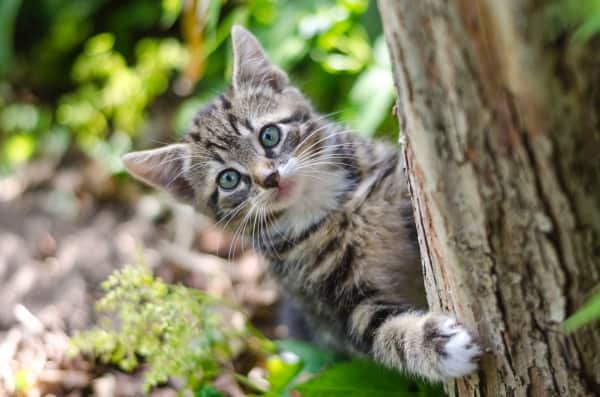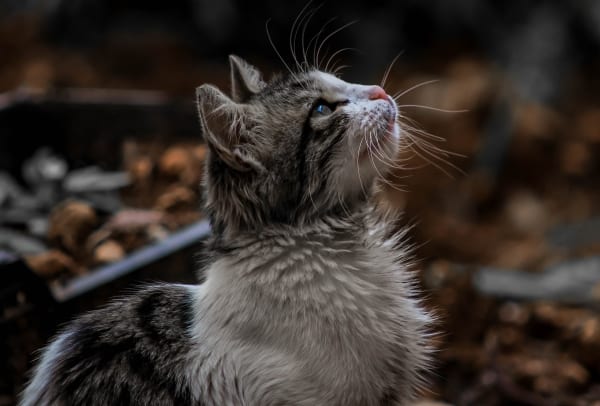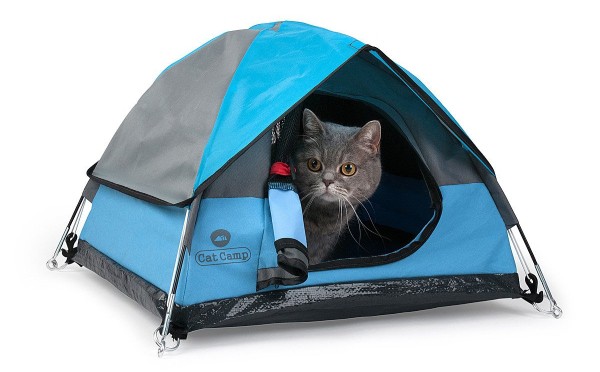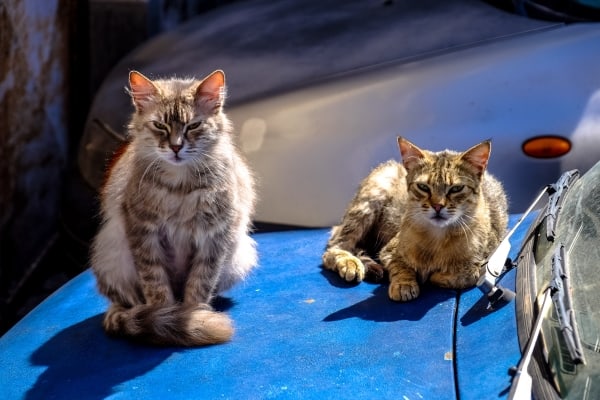
Camping with cats is far more popular than you might think. The trouble is there doesn’t seem to be as much information on camping with our feline friends as there is on other types of pets.
I’m hoping to change that with this post. In this post, you’ll find everything you need to know before you go camping with your cat.
Table of Contents
Planning Ahead
Many campgrounds, state, and national parks will allow you to bring pets. Some will specifically say they allow dogs. Generally, if a campground will allow you to camp with your dogs, they’ll allow you to camp with your cats as well. If you’re unsure about your camping destination’s pet policy, check their website, shoot them an email, and as a last resort, give them a call.
It is always best to have the camping destination’s pet policy in writing but if they aren’t answering emails you’ll have to settle for verbal confirmation. Just make sure you get the name of the person you talk to and keep this information on hand should the campground try to reject you and your cat when you arrive.
Meeting Your Cat’s Needs
Your cat will have its usual needs like food, water, and shelter as well as some additional camping-specific needs. For example, you may need to plan out how much water to bring and you may need to take special precautions when handling your cat’s food.
Here are some items you’ll need to consider when bringing your cat camping with you:
- Food needs to be stored carefully.
- You may need to pack your own water.
- A litter box might be an essential part of leave-no-trace.
Food
It’s obvious that your cat will need to eat while camping. It might not be obvious that your cat’s food will also need to be protected both while the cat is eating and while the cat is not. Bears, mice, and rats really aren’t all that picky. They’ll eat people food and cat food just as easily as they’ll eat “bear food” and “mouse food”.
For this reason, you may need to pack your cat’s food away in bear lockers or bear canisters. When wilderness camping with your cat you may even need to hang your cat’s food up in a tree. Check with the campground or park to see what their requirements are for safeguarding food and be sure to follow these requirements to the letter. Mice and rats will probably steer clear of your cat but a bear will have no qualms about entering a tent with a cat in it.
Water
According to PreventativeVet.com, a cat typically drinks a little less than an ounce of water per day per pound. If you have a 12-pound cat you might consider packing about 12 ounces of water for your cat for each day you’re out camping. This is pretty simple as a large bottle of water could keep your cat hydrated over an entire weekend of camping.
If your campsite has water located right on-site you may not even have to bother packing water at all. This being said, for the small amount of space it takes up, you’d be better off packing your water in with you. This will ensure that your cat does not end up drinking water that might make him sick.

Cat Dehydration
Left alone without enough water, a cat will dehydrate just like the rest of us. Severe dehydration can be deadly so it’s important that you’re able to identify the signs of dehydration.
Here is what to look out for:
- Decreased Urination
- Sticky Gums
- Panting
The three easiest signs of cat dehydration to watch out for are a decrease in urination, sticky gums, and panting. If you’ve packed a litter box and your cat is using it you shouldn’t have trouble identifying whether or not your cat is going to the bathroom.
However, if you are having trouble identifying your cat’s bathroom habits, you can still watch out for sticky gums and panting. If your cat’s gums look dry, it is time to make sure she drinks some extra water.
Failing this, you can check to see if your cat is panting. Panting is often done by dogs but it is unusual behavior in cats. A cat will not pant unless it has started to overheat. An overheated cat is most likely a dehydrated cat and it’s time to make sure your cat is drinking enough water.
Litter Box
When car camping with your cat, it is important that you do not pollute your campsite. While it might be normal for a cat to go to the bathroom outside in a less-traveled area, it is harmful to the environment for your cat to go to the bathroom in a heavily trafficked environment.
Pack a litter box and your cat will use that instead of your campsite. When your trip is over, bag up your cat’s waste and bring it with you.
When wild camping, you may not have the option of packing in a litter box. If this is the case, bring some bags to carry the waste out with you or plan on digging a hole to bury your cat’s waste. While some cats will cover their feces themselves, they usually will not dig far enough into the ground to be effective. You’ll want to bury your cat’s feces at least six to eight inches deep. Ironically, this type of hole is actually called a cat hole.
Equipment and Gear Your Cat Will Need When Camping
You’re going to need some extra gear when camping with your cat. Here are some of the items I’d recommend you bring with you.
Essential
- A Cat Harness
- A Leash
- A Crate
- Food and Water Dishes That Won’t Blow Away
- Tie Out Stakes or Rope
All campgrounds and parks will require you to keep your cat leashed at all times. A cat harness with a leash is the best way to do this. This will ensure that your cat cannot free themselves from their collar.
You’ll probably want to crate your cat at some point as well. This could be during the car ride to your destination or while you set your tent up and take your tent down. Of course, you could use tie out stakes and rope to secure your cat while you put your tent up, but what happens if it rains? Will you leave your cat out in the rain while you erect your tent?
Bring your cat crate along and you safely place your cat in the crate and under a tarp or inside of your car – heat permitting.
The weather can also have an effect on your cat’s food and water bowls as well. You’ll want to get dishes that can be staked or weighed down so that they don’t blow away each time the wind picks up. Alternatively, you could put these dishes in the cat’s crate so that they’ll have additional protection from the elements.
Just remember to remove the food each night so that you can properly store it safely away from bears and other animals.
Optional
- Tent Protection
- An Outdoor Playpen
- Cat Backpack Carrier
Will your cat be staying in your tent? If so, you’ll have to worry about your cat’s claws. Tents are often fragile and a cat’s claws can easily ruin the bottom of your tent. Place a mat or thick tarp on the bottom of your tent so you won’t have to worry about holes and tears.
Do I Need to Put a Tarp Under My Tent? | When and why to use a tarp.
While you’re setting up your tent, you might want to consider putting your cat in an outdoor playpen. Outdoor cat playpens often set up just like miniature tents and they can provide a leash-free run for your cat to enjoy while you set up your tent, cook your food, and hang out by the fire.
Are you planning on taking your cat for a hike? An athletic cat may not have any trouble keeping up with your while you hike but many will. Bring along a cat backpack carrier and your cat can hang out on your back while you explore the local trails.

Keeping Your Cat Safe While Camping
Keeping your cat safe while camping is essential. Here are some tips you can use to help you do this:
- Get your cat vaccinated ahead of time.
- Make sure your cat’s tags are up-to-date and in place.
- Install a GPS system.
- Bring a first-aid kit.
- Research local animal hospitals.
- Keep your cat close.
Your cat’s shots should be up-to-date before you head out. At home, your cat might not have to worry about getting worms or other parasites but at the campsite, this could be a totally different story. In addition to vaccinations, you’ll want to make sure that your cat has been treated for fleas and ticks.
You can also bring along along a flea and tick comb to brush your cat with each day. This will help you catch any fleas or ticks before they have a chance to settle into your cat’s fur.
While you’re at the vet, make sure your cat’s tags are up-to-date and in place. Things like these are easy to forget when your cat mostly stays at home. However, proper tags may be the only way you get your cat back home after he gets lost.

Speaking of lost cats, did you know that you can buy GPS tags that will communicate with personal trackers? Get one of these devices and you can track your cat even if she ends up lost in the woods. This is important as cats tend to hide when they are lost which makes them harder to find compared to other types of pets.
Not only should you know where your cat is at all times you should have her close to you at all times as well. Cats are fierce animals but they are no match for large predators. Foxes, coyotes, wolves, owls, hawks, vultures, eagles, mountain lions, and bears can all kill your cat in an instant. Even smaller animals like raccoons and badgers can be a serious threat to your cat’s safety.
Keep your cat close to you to deter animals from approaching and never leave your cat alone or unattended to.
Medical Treatment
You should always have a cat-specific first-aid kit on hand for treating your cat at the campsite. The cat first aid kit should have a cat first-aid manual the number to the ASPCA poison control center, which is 1-800-426-4435, and self-cling bandages. These bandages will stick to your cat without getting stuck to his fur.
Additionally, you’ll want to know where you can go in the event of a medical emergency. Look up the number and address of local emergency animal hospitals and keep this with your first-aid supplies. You do not want to have to look up this information after the fact.
Additional Tips to Consider When Camping With Your Cat
Take a Test Drive
If you’ve never been hiking or camping with your cat, you might want to start off slow. For example, you can simulate camping with your cat by setting up a tent in your back yard. This will get your cat used to the idea and you’ll be able to see what your cat does and doesn’t need before you head out on your adventure.
What about hiking? If you’ve never been hiking with your cat either, you might want to take your cat out for a day hike before you subject him to a weekend of hiking. Imagine going away for the weekend only to find that it is dreadfully difficult to go hiking with your cat. In this case, it is better to know in advance so that you can change the way you camp that weekend or leave your cat behind if necessary.

Related Questions
Will My Cat Like Camping
Some cats love to go camping. They like hiking, riding in kayaks, and even climbing. Other cats will hate the whole experience the moment you leave the house. If you have a cat that is prone to getting carsick and who doesn’t like to be outside much, you may want to leave your cat at home.
On the other hand, if your cat likes to run around your yard or go mountain climbing like Millie the mountain climbing cat, then she’ll love the adventure of camping.
How Long Can I Leave My Cat Alone
PetMD.com recommends that you never leave your cat alone for more than 24 hours. If you’ve tested out camping with your cat in your backyard and have decided to leave your cat alone over the weekend, you may want to have someone check on them.
The wonderful aspect of owning a cat is that they are relatively low-maintenance pets. You can clean your cat’s litter box, and buy an automatic water bowl and automatic food bowl and your pet sitter won’t have to do much work at all. In fact, you could probably just ask your neighbor to stop by to hang out with your cat for a few minutes just to be sure she is healthy and that the automatic food station is working as it should.
In Closing
Camping with your cat can be a wonderful experience that both you and your cat look forward to each year. However, not all cats like camping and you shouldn’t force it upon a cat that just isn’t up to it. Take your cat out a few times and if they still haven’t adjusted to camping after the second or third time then you may want to leave them at home on the fourth.




